Start-Up Mechanism and Dynamic Process of Landslides in the Full High Waste Dump
Abstract
1. Introduction
2. Background and Method
2.1. Geology and Geomorphology
2.2. Hydrometeorological Conditions
2.3. Composition and Gradation of the Waste Dump Soil
2.4. Method
3. The SPH Model
4. Results and Discussion
4.1. Description of Landslides in the Full High Waste Dump
4.2. Start-Up Mechanism of Landslides
4.3. Dynamic Process of Landslides
4.4. Discussion
5. Conclusions
Author Contributions
Funding
Acknowledgments
Conflicts of Interest
References
- Griffiths, J.S.; Whitworth, M. Engineering geomorphology of landslides. In Landslides: Types, Mechanisms and Modeling; Clague, J.J., Stead, D., Eds.; Cambridge University Press: Cambridge, UK, 2015; pp. 172–186. ISBN 9780511740367. [Google Scholar]
- Segoni, S.; Piciullo, L.; Gariano, S.L. A review of the recent literature on rainfall thresholds for landslide occurrence. Landslides 2018, 15, 1483–1501. [Google Scholar] [CrossRef]
- Tang, H.; Li, C.; Hu, X.; Wang, L.; Criss, R.; Su, A.; Wu, Y.; Xiong, C. Deformation response of the Huangtupo landslide to rainfall and the changing levels of the Three Gorges Reservoir. Bull. Eng. Geol. Environ. 2015, 74, 933–942. [Google Scholar] [CrossRef]
- Liu, W.; Wang, D.; Zhou, J.; He, S. Simulating the Xinmo landslide runout considering entrainment effect. Environ. Earth Sci. 2019, 78, 1–16. [Google Scholar] [CrossRef]
- He, M.; Sousa, L.; Müller, A.; Vargas, E., Jr.; Sousa, R.; Oliveira, C.; Gong, W. Numerical and safety considerations about the Daguangbao landslide induced by the 2008 Wenchuan earthquake. J. Rock Mech. Geotech. Eng. 2019, 11, 1019–1035. [Google Scholar] [CrossRef]
- Fan, X.; Tang, J.; Tian, S.; Jiang, Y. Rainfall-induced rapid and long-runout catastrophic landslide on 23 July 2019 in Shuicheng, Guizhou, China. Landslides 2020. [Google Scholar] [CrossRef]
- Xu, W.; Jie, Y.; Li, Q.; Wang, X.; Yu, Y. Genesis, mechanism, and stability of the Dongmiaojia landslide, yellow river, China. Int. J. Rock Mech. Min. Sci. 2014, 67, 57–68. [Google Scholar] [CrossRef]
- Fan, X.; Zhan, W.; Dong, X.; Westen, C.; Xu, Q.; Dai, L.; Yang, Q.; Huang, R.; Havenith, H. Analyzing successive landslide dam formation by different triggering mechanisms: The case of the Tangjiawan landslide, Sichuan, China. Eng. Geol. 2018, 243, 128–144. [Google Scholar] [CrossRef]
- Tang, Y.; Wu, W.; Yin, K.; Wang, S.; Lei, G. A hydro-mechanical coupled analysis of rainfall induced landslide using a hypoplastic constitutive model. Comput. Geotech. 2019, 112, 284–292. [Google Scholar] [CrossRef]
- Zhao, N.; Zhang, R.; Yan, E.; He, X.; Liu, J. A dynamic model for rapid startup of high-speed landslides based on the mechanism of friction-induced thermal pressurization considering vaporization. Landslides 2020, 17, 1545–1560. [Google Scholar] [CrossRef]
- Wei, X.; Fan, W.; Chai, X.; Cao, Y.; Nan, Y. Field and numerical investigations on triggering mechanism in typical rainfall-induced shallow landslides: A case study in the Ren River catchment, China. Nat. Hazards 2020. [Google Scholar] [CrossRef]
- Zhu, L.; Liang, H.; He, S.; Liu, W.; Zhang, Q.; Li, G. Failure mechanism and dynamic processes of rock avalanche occurrence in Chengkun railway, China, on August 14, 2019. Landslides 2020, 17, 943–957. [Google Scholar] [CrossRef]
- Bai, S.; Lu, P.; Thiebes, B. Comparing characteristics of rainfall- and earthquake-triggered landslides in the Upper Minjiang catchment, China. Eng. Geol. 2020, 268, 105518. [Google Scholar] [CrossRef]
- Liu, Z.; Su, L.; Zhang, C.; Iqbal, J.; Hu, B.; Dong, Z. Investigation of the dynamic process of the Xinmo landslide using the discrete element method. Comput. Geotech. 2020, 123, 103561. [Google Scholar] [CrossRef]
- Huang, A.; Lee, J.; Ho, Y.; Chiu, Y.; Cheng, S. Stability monitoring of rainfall-induced deep landslides through pore pressure profile measurements. Soils Found. 2012, 52, 737–747. [Google Scholar] [CrossRef]
- Chen, S.; Chou, H.; Chen, S.; Wu, C.; Lin, B. Characteristics of rainfall-induced landslides in Miocene formations: A case study of the Shenmu watershed, Central Taiwan. Eng. Geol. 2014, 169, 133–146. [Google Scholar] [CrossRef]
- Palenzuela, J.; Jiménez-Perálvarez, J.; Chacón, J.; Irigaray, C. Assessing critical rainfall thresholds for landslide triggering by generating additional information from a reduced database: An approach with examples from the Betic Cordillera (Spain). Nat. Hazards 2016, 84, 185–212. [Google Scholar] [CrossRef]
- Yang, Z.; Pourghasemi, H.; Lee, Y. Fractal analysis of rainfall-induced landslide and debris flow spread distribution in the Chenyulan Creek Basin, Taiwan. J. Earth Sci. 2016, 27, 151–159. [Google Scholar] [CrossRef]
- Chan, H.-C.; Chen, P.-A.; Lee, J.-T. Rainfall-Induced Landslide Susceptibility Using a Rainfall–Runoff Model and Logistic Regression. Water 2018, 10, 1354. [Google Scholar] [CrossRef]
- Li, Z.; Zhang, F.; Gu, W.; Dong, M. The Niushou landslide in Nanjing City, Jiangsu Province of China: A slow-moving landslide triggered by rainfall. Landslides 2020. [Google Scholar] [CrossRef]
- Capolongo, D.; Refice, A.; Mankelow, J. Evaluating Earthquake-Triggered Landslide Hazard at the Basin Scale through Gis in the Upper Sele River Valley. Surv. Geophys. 2002, 23, 595–625. [Google Scholar] [CrossRef]
- Sassa, K.; Fukuoka, H.; Wang, F.; Wang, G. Dynamic properties of earthquake-induced large-scale rapid landslides within past landslide masses. Landslides 2005, 2, 125–134. [Google Scholar] [CrossRef]
- Budimir, M.; Atkinson, P.; Lewis, H. Earthquake-and-landslide events are associated with more fatalities than earthquakes alone. Nat. Hazards 2014, 72, 895–914. [Google Scholar] [CrossRef]
- Regmi, N.R.; Walter, J.I. Detailed mapping of shallow landslides in eastern Oklahoma and western Arkansas and potential triggering by Oklahoma earthquakes. Geomorphology 2019, 106806. [Google Scholar] [CrossRef]
- Notti, D.; Galve, J.; Mateos, R.; Monserrat, O.; Lamas-Fernández, F.; Fernández-Chacón, F.; Roldán-García, F.; Pérez-Peña, J.; Crosetto, M.; Azañón, J. Human-induced coastal landslide reactivation. Monitoring by PSInSAR techniques and urban damage survey (SE Spain). Landslides 2015, 12, 1007–1014. [Google Scholar] [CrossRef]
- Wieczorek, G.; Eaton, L.; Yanosky, T.; Turner, E. Hurricane-induced landslide activity on an alluvial fan along Meadow Run, Shenandoah Valley, Virginia (eastern USA). Landslides 2006, 3, 95–106. [Google Scholar] [CrossRef]
- Lucy, L. A numerical approach to the testing of the fission hypothesis. Astron. J. 1977, 82, 1013–1024. [Google Scholar] [CrossRef]
- Gingold, R.; Monaghan, J. Smoothed particle hydrodynamics: Theory and application to non-spherical stars. Mon. Not. R. Astron. Soc. 1977, 181, 375–389. [Google Scholar] [CrossRef]
- Pasculli, A.; Minatti, L.; Sciarra, N.; Paris, E. SPH modeling of fast muddy debris flow: Numerical and experimental comparison of certain commonly utilized approaches. Ital. J. Geosci. 2013, 132, 350–365. [Google Scholar] [CrossRef]
- Pasculli, A.; Minatti, L.; Audisio, C.; Sciarra, N. Insights on the application of some current SPH approaches for the study of muddy debris flow: Numerical and experimental comparison. WIT Trans. Eng. Sci. 2014, 82, 3–14. [Google Scholar] [CrossRef]
- Huang, Y.; Cheng, H.; Dai, Z.; Xu, Q.; Liu, F.; Sawada, K.; Moriguchi, S.; Yashima, A. SPH-based numerical simulation of catastrophic debris flows after the 2008 Wenchuan earthquake. Bull. Eng. Geol. Environ. 2015, 74, 1137–1151. [Google Scholar] [CrossRef]
- Braun, A.; Cuomo, S.; Petrosino, S.; Wang, X.; Zhang, L. Numerical SPH analysis of debris flow run-out and related river damming scenarios for a local case study in SW China. Landslides 2018, 15, 535–550. [Google Scholar] [CrossRef]
- Zhu, C.; Huang, Y.; Zhan, L. SPH-based simulation of flow process of a landslide at Hongao landfill in China. Nat. Hazards 2018, 93, 1113–1126. [Google Scholar] [CrossRef]
- Zhang, W.; Ji, J.; Gao, Y. SPH-based analysis of the post-failure flow behavior for soft and hard interbedded earth slope. Eng. Geol. 2020, 267, 105446. [Google Scholar] [CrossRef]
- Tao, Z.; Zhu, C.; Wang, Y.; Wang, J.; He, M.; Zhang, B. Research on Stability of an Open-Pit Mine Dump with Fiber Optic Monitoring. Geofluids 2018, 9631706. [Google Scholar] [CrossRef]
- Deane, E.; Macciotta, R.; Hendry, M.T.; Gräpel, C.; Skirrow, R. Leveraging historical aerial photographs and digital photogrammetry techniques for landslide investigation—A practical perspective. Landslides 2020, 17, 1989–1996. [Google Scholar] [CrossRef]
- García-Delgado, H. The San Eduardo Landslide (Eastern Cordillera of Colombia): Reactivation of a deep-seated gravitational slope deformation. Landslides 2020, 17, 1951–1964. [Google Scholar] [CrossRef]
- Hong, Y.; Adler, R.; Huffman, G. Use of satellite remote sensing data in the mapping of global landslide susceptibility. Nat. Hazards 2007, 43, 245–256. [Google Scholar] [CrossRef]
- Liu, G.; Liu, M. Smoothed Particle Hydrodynamics: A Meshfree Particle Method; World Scientific: Singapore, 2003. [Google Scholar]
- Swegle, J.; Attaway, S.; Heinstein, M. An Analysis of Smoothed Particle Hydrodynamics; Sandia National Labs: Albuquerque, NM, USA, 1994. [Google Scholar]
- Abaqus Analysis User’s Guide 6.14. Available online: http://130.149.89.49:2080/v6.14/books/usb/default.htm (accessed on 11 September 2020).
- Menetrey, P.; Willam, K. Triaxial Failure Criterion for Concrete and its Generalization. ACI Struct. J. 1995, 92, 311–318. [Google Scholar]
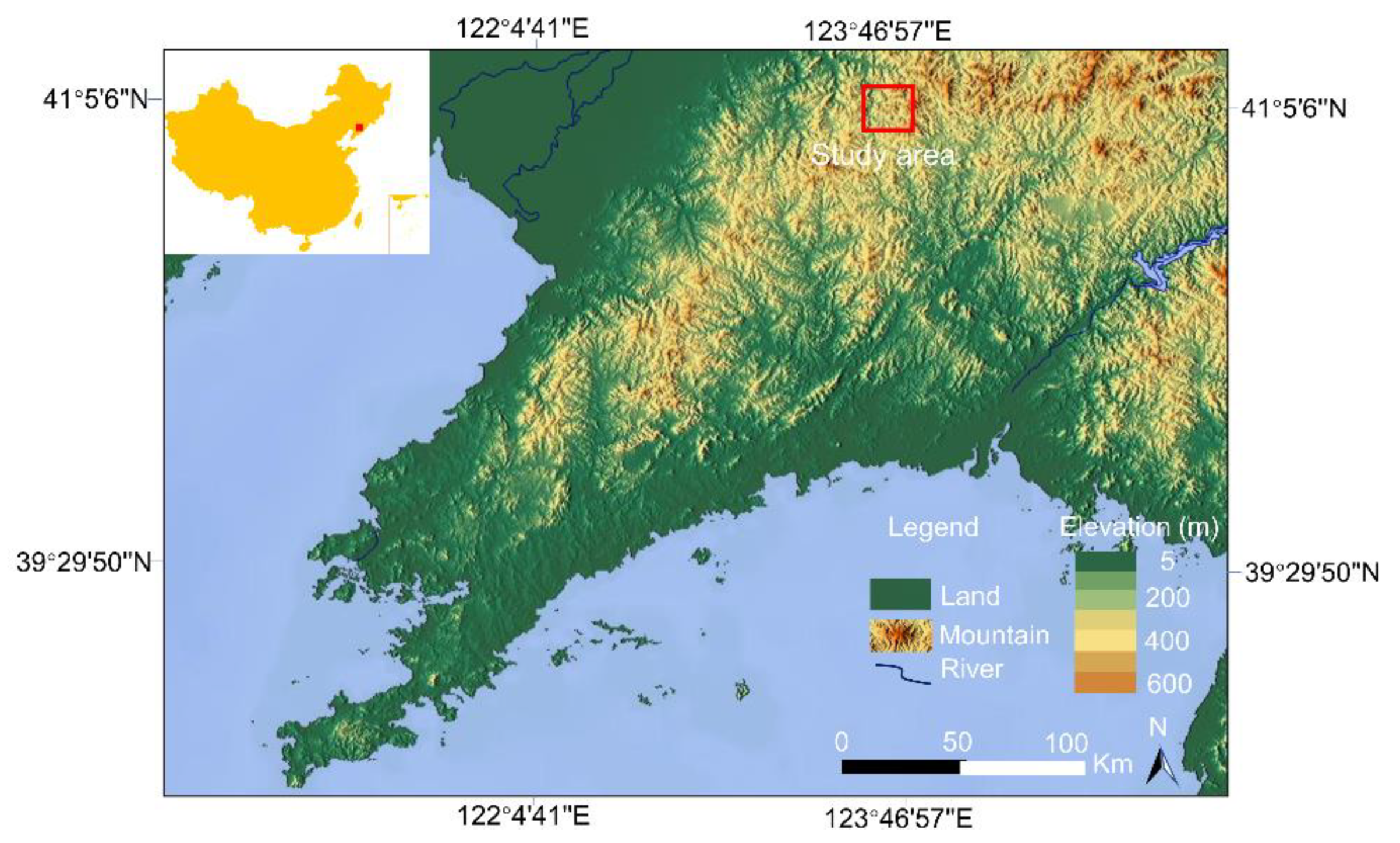
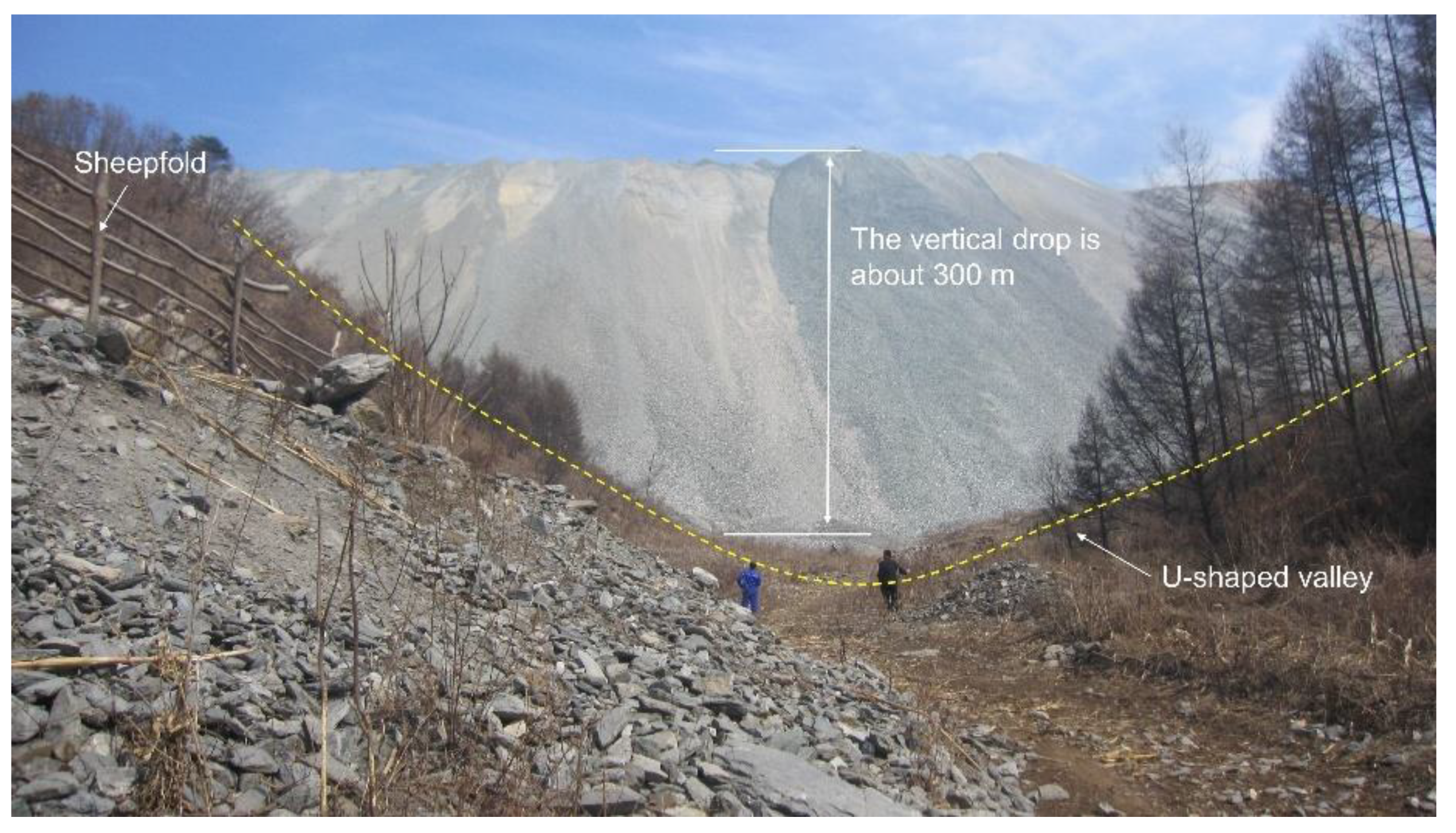
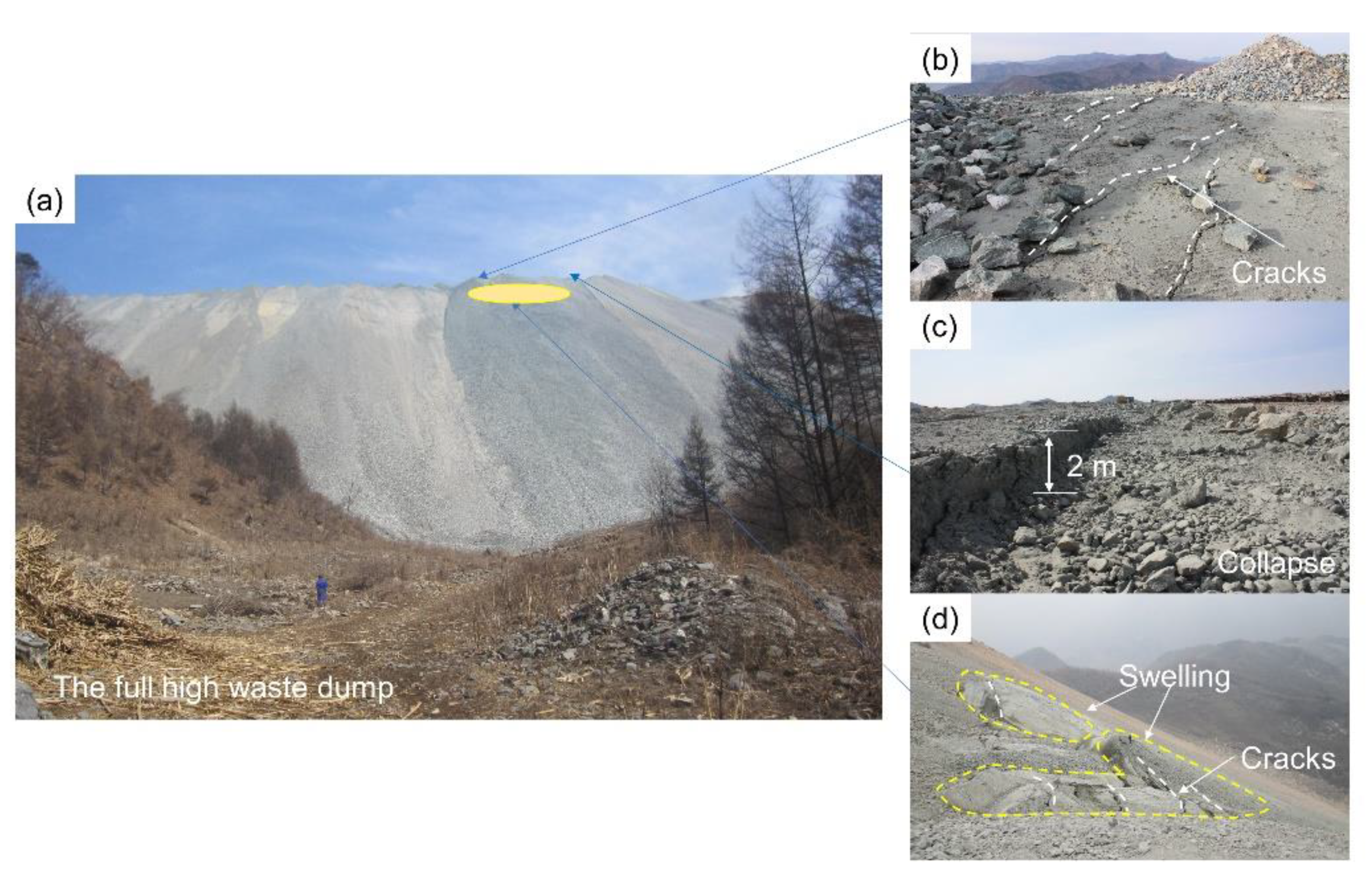


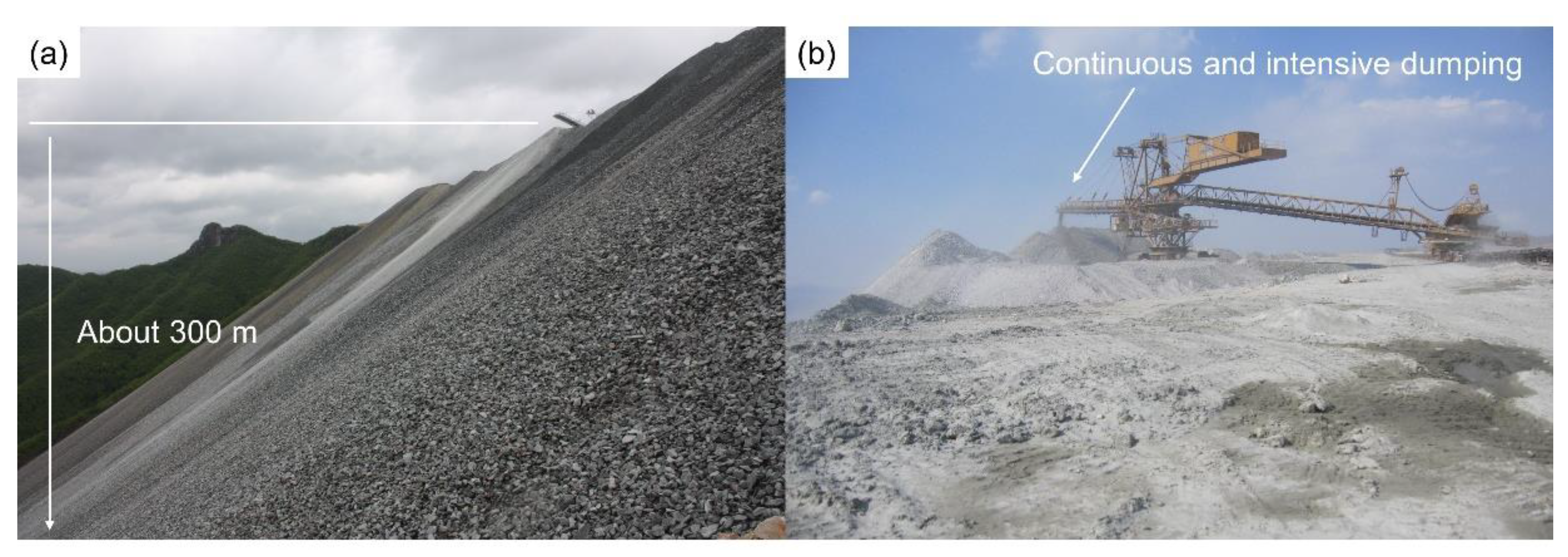

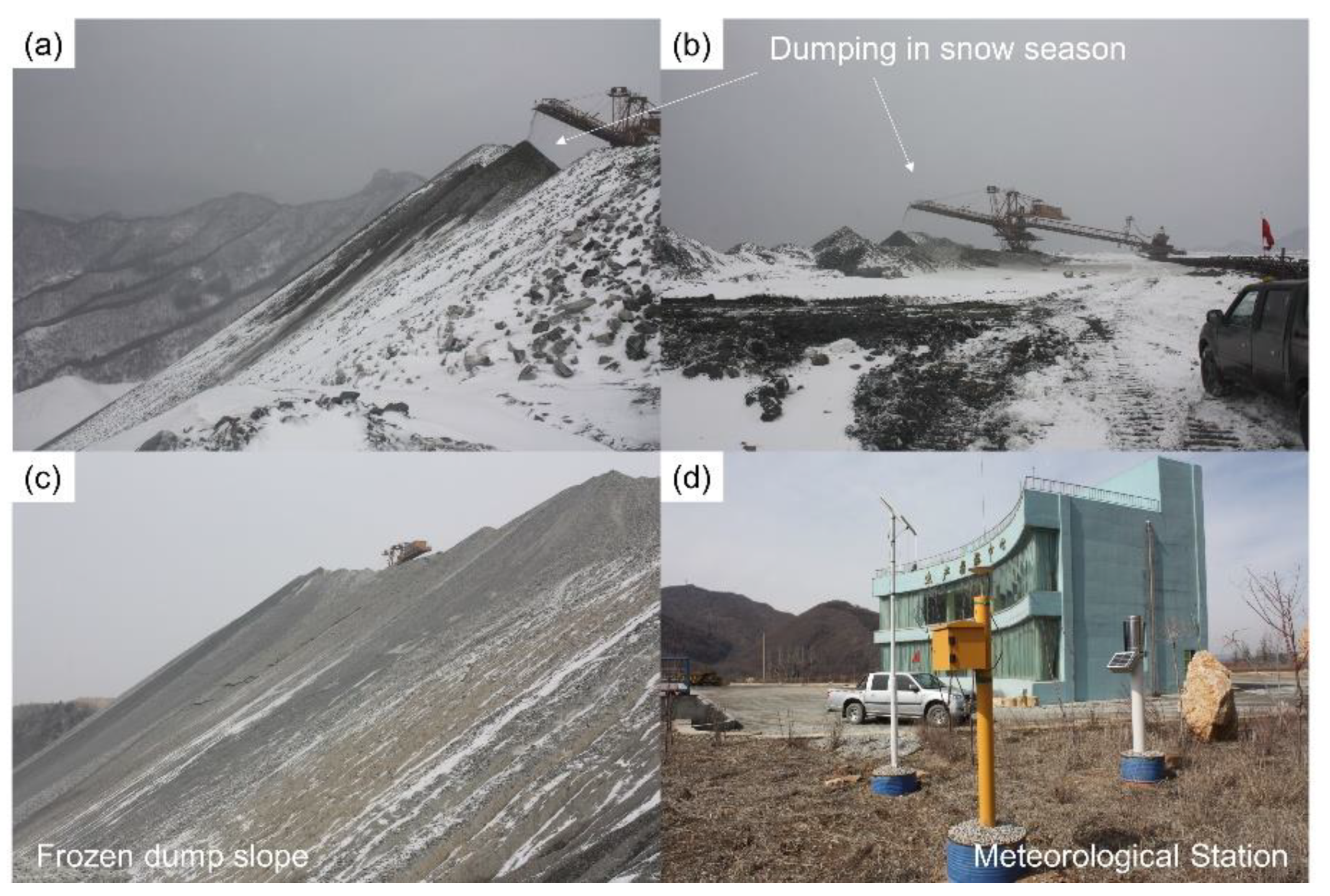


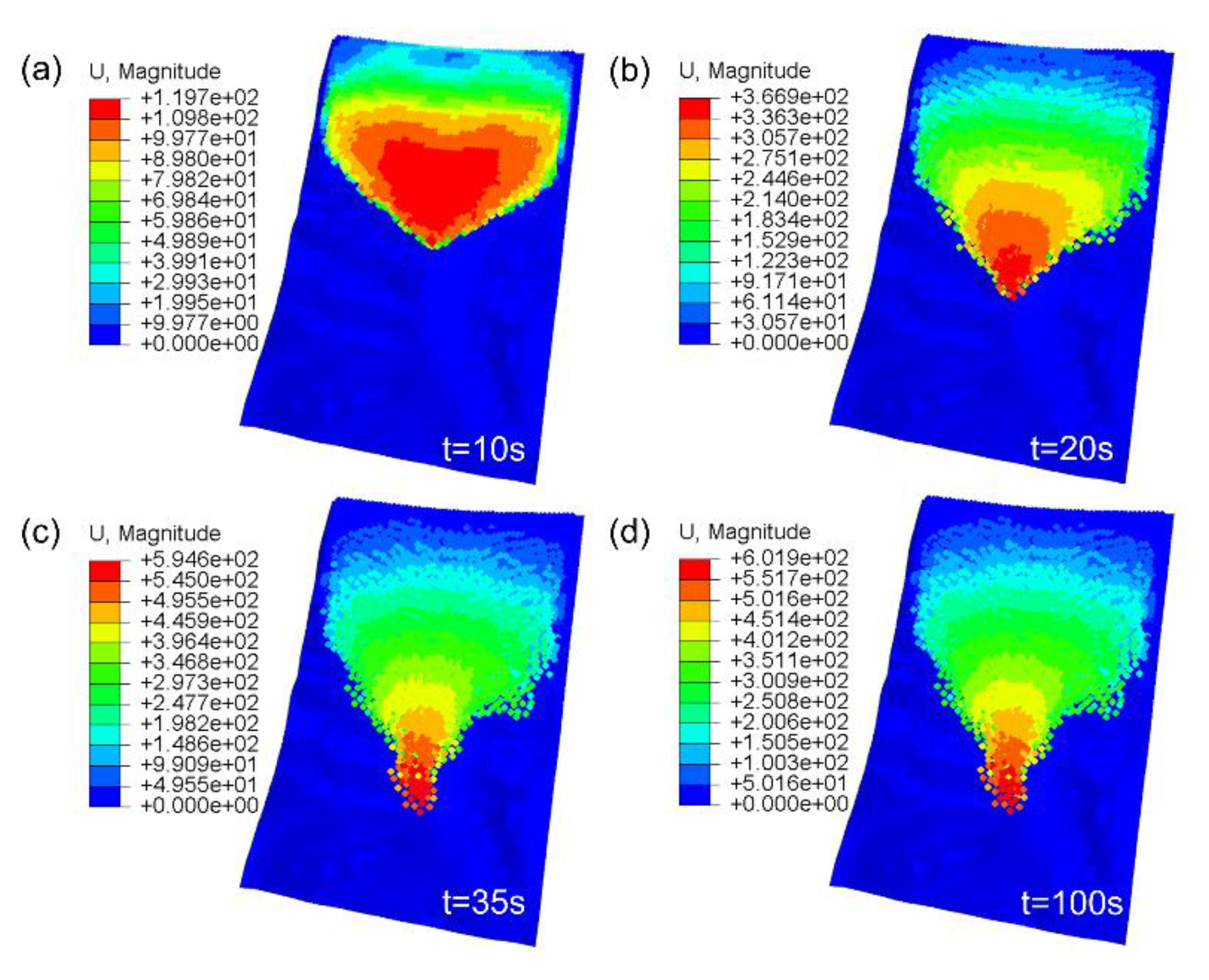
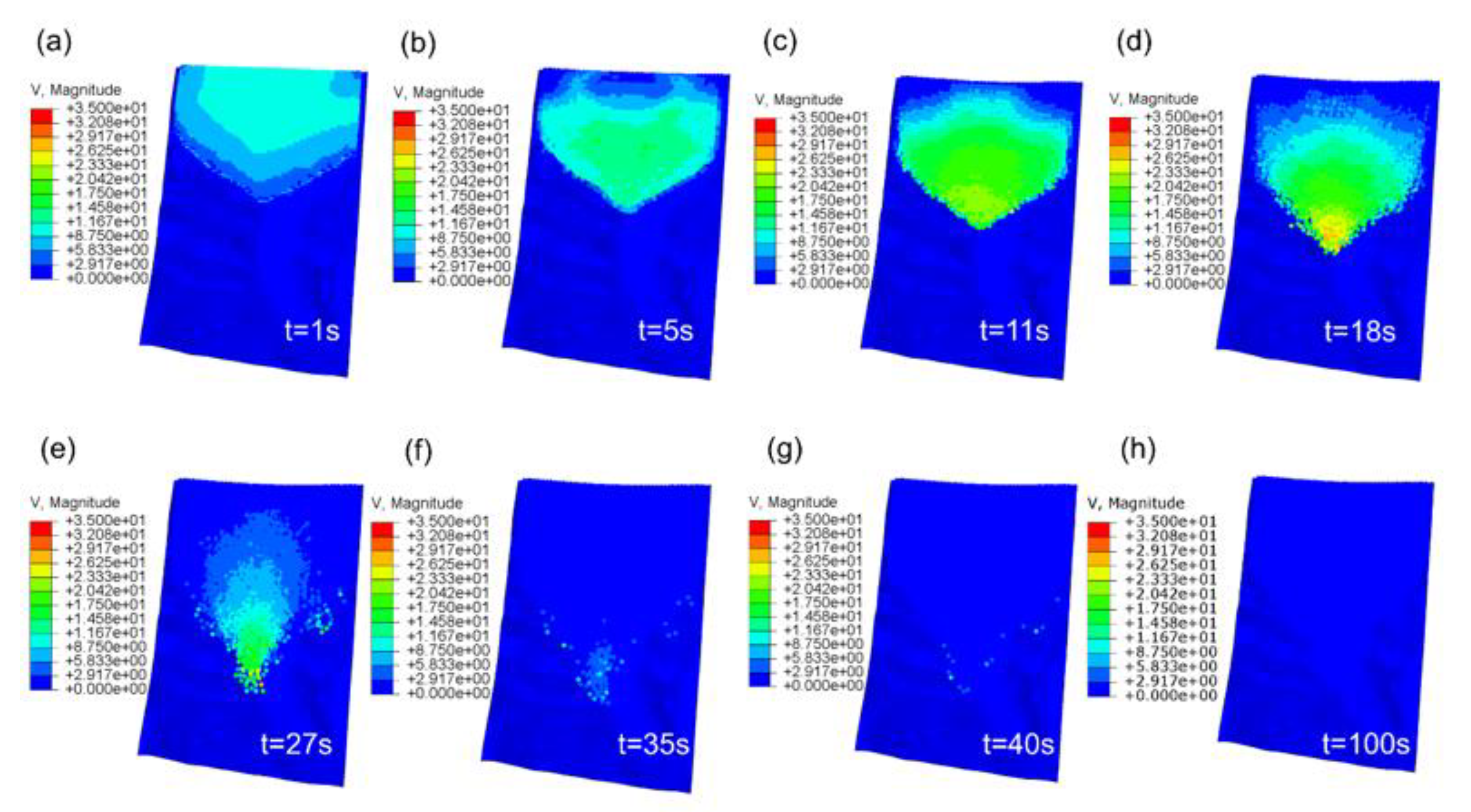
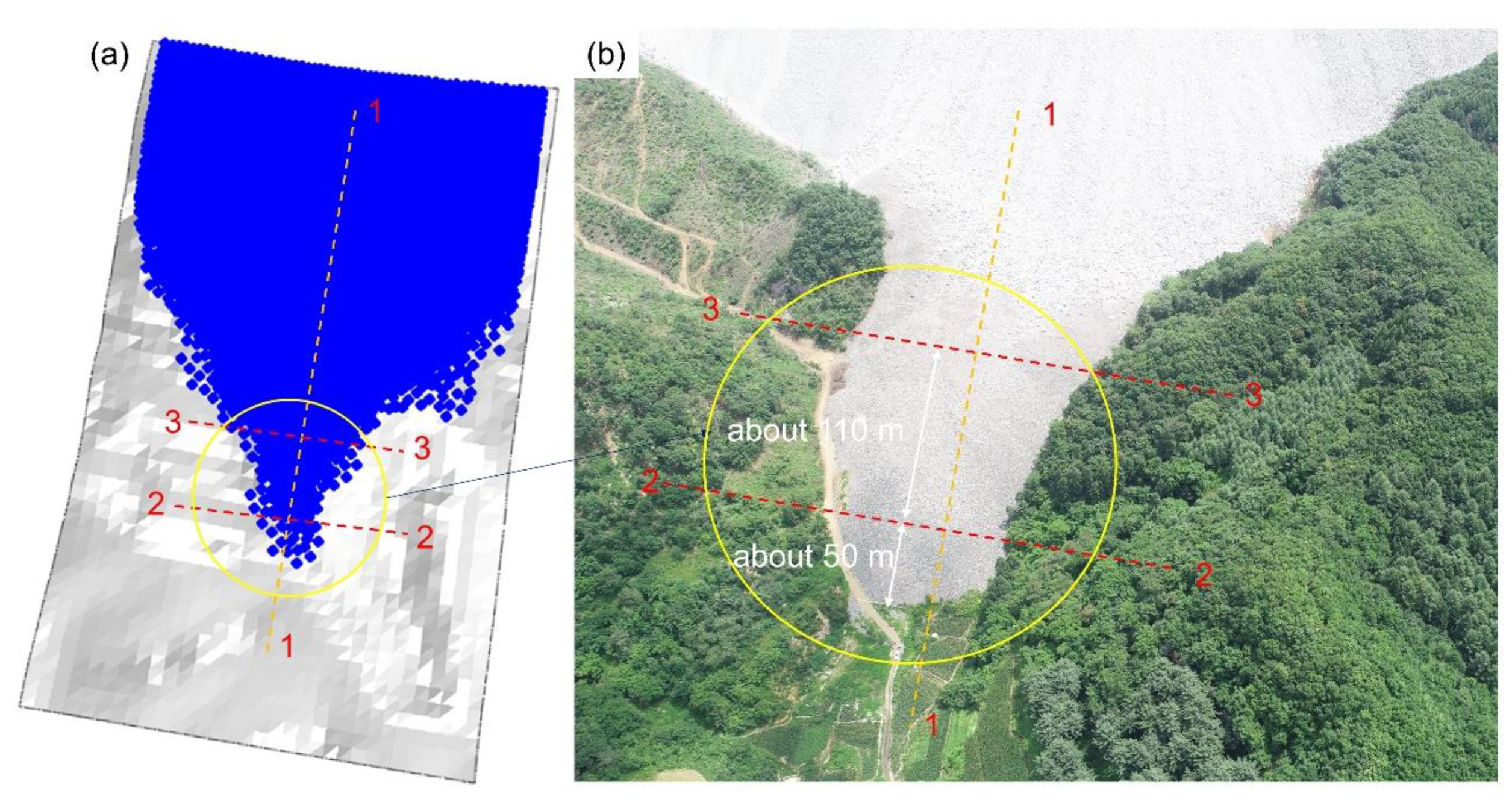
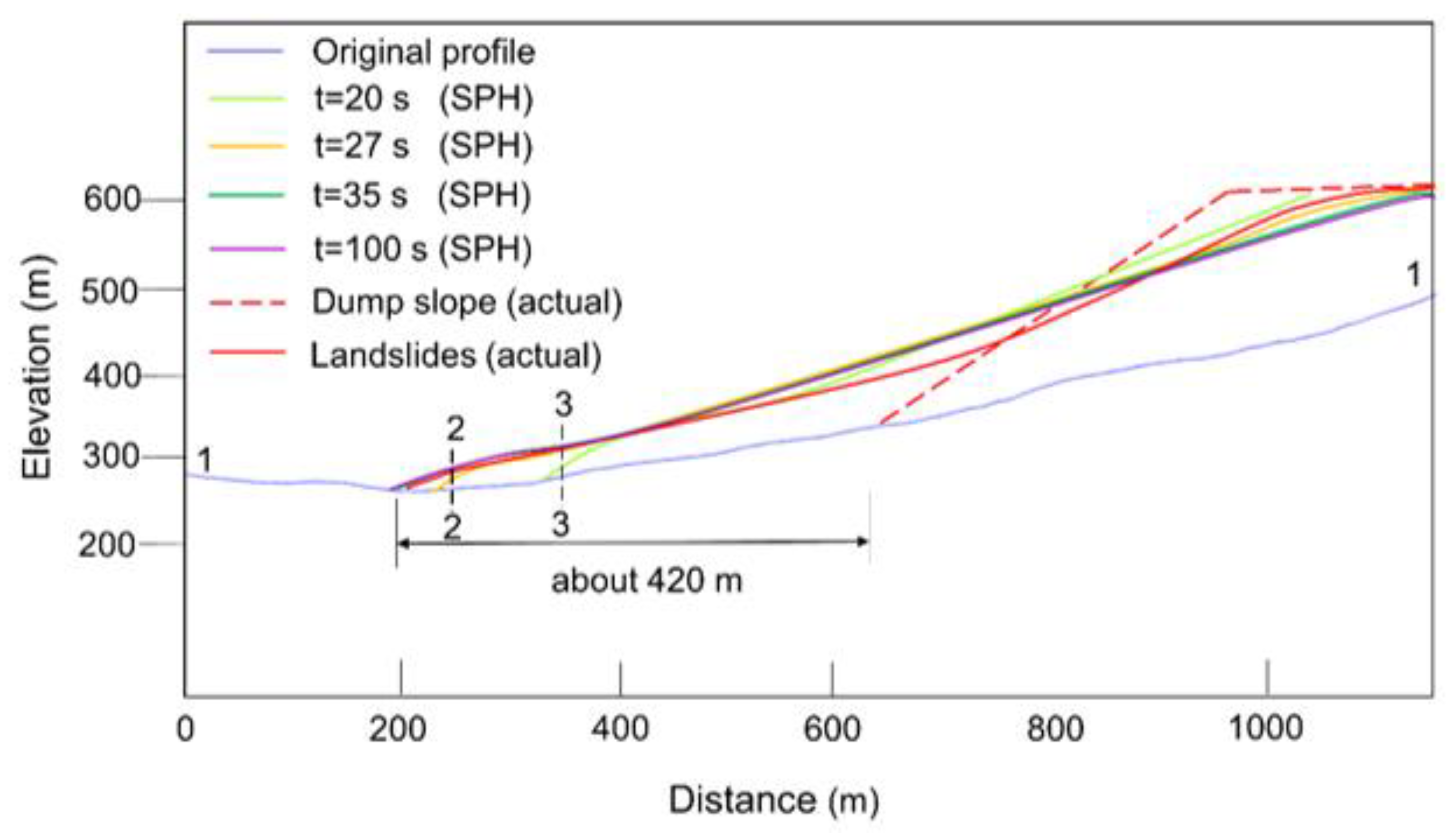

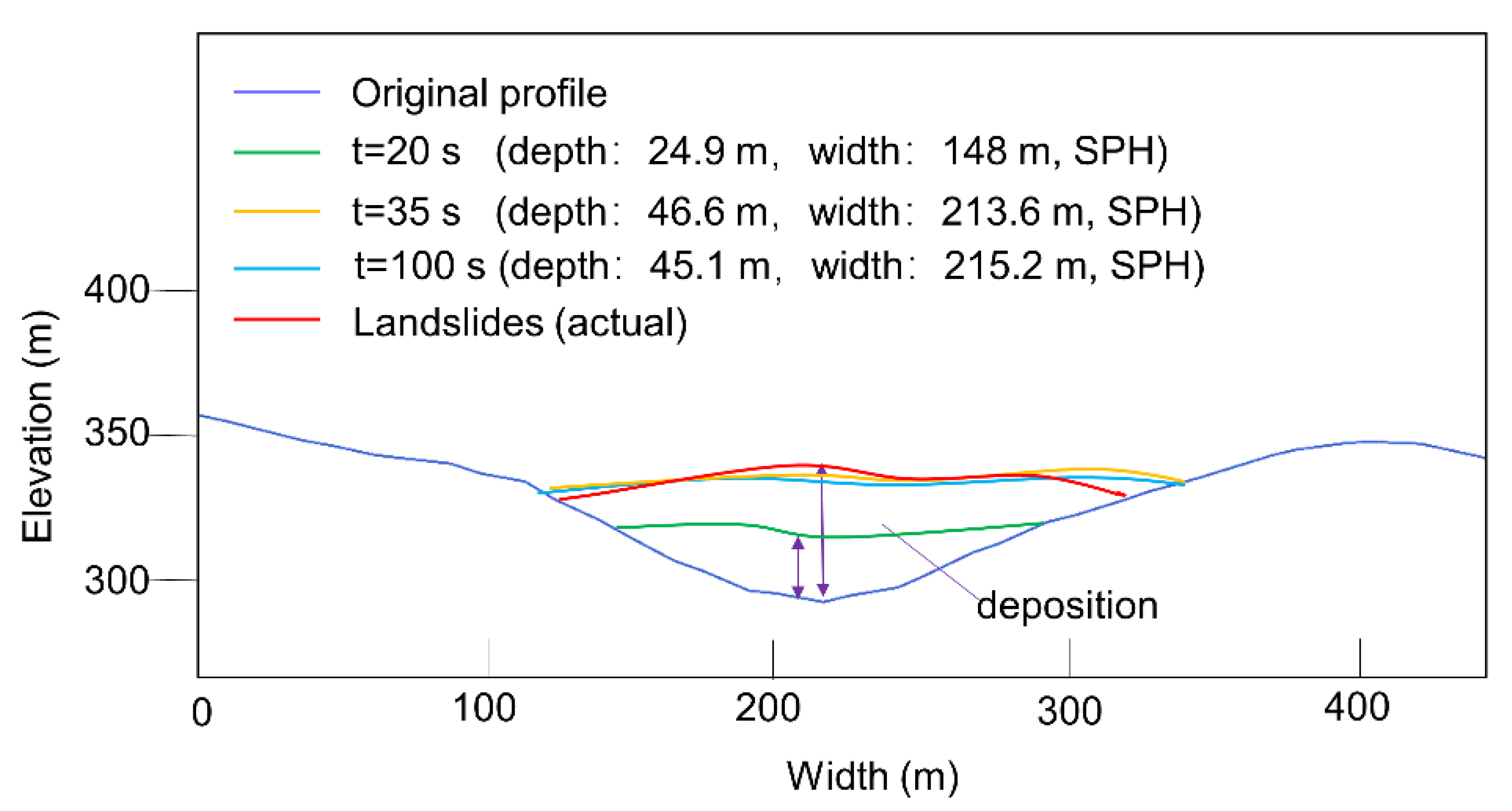
| Grain Group Classification | Grain Size Range (d/mm) | Content (%) | |
|---|---|---|---|
| Big grain | Boulder (rock) | d > 200 | 5.50 |
| Pebble (gravel) | 200 > d > 60 | 17.72 | |
| Coarse grain | Coarse gravel | 60 > d > 20 | 27.15 |
| Medium gravel | 20 > d > 5 | 27.55 | |
| Fine gravel | 5 > d > 2 | 10.90 | |
| Coarse sand | 2 > d > 0.5 | 4.49 | |
| Medium sand | 0.5 > d > 0.25 | 2.89 | |
| Fine sand | 0.25 > d > 0.075 | 2.00 | |
| Fine grain | Silt grain | 0.075 > d > 0.005 | 1.00 |
| Clay grain | 0.005 > d | 0.80 |
| Property | Value | |
|---|---|---|
| Dumpling soil | Young’s modulus (MPa) | 26.23 |
| Poisson’s ratio | 0.36 | |
| Cohesion (KPa) | 1.0 | |
| Friction angle φ (°) | 20 | |
| Density (Kg/m3) | 2250 |
© 2020 by the authors. Licensee MDPI, Basel, Switzerland. This article is an open access article distributed under the terms and conditions of the Creative Commons Attribution (CC BY) license (http://creativecommons.org/licenses/by/4.0/).
Share and Cite
Cao, C.; Feng, J.; Tao, Z. Start-Up Mechanism and Dynamic Process of Landslides in the Full High Waste Dump. Water 2020, 12, 2543. https://doi.org/10.3390/w12092543
Cao C, Feng J, Tao Z. Start-Up Mechanism and Dynamic Process of Landslides in the Full High Waste Dump. Water. 2020; 12(9):2543. https://doi.org/10.3390/w12092543
Chicago/Turabian StyleCao, Chunhui, Jili Feng, and Zhigang Tao. 2020. "Start-Up Mechanism and Dynamic Process of Landslides in the Full High Waste Dump" Water 12, no. 9: 2543. https://doi.org/10.3390/w12092543
APA StyleCao, C., Feng, J., & Tao, Z. (2020). Start-Up Mechanism and Dynamic Process of Landslides in the Full High Waste Dump. Water, 12(9), 2543. https://doi.org/10.3390/w12092543






